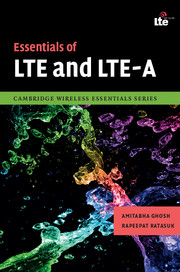Book contents
6 - LTE-Advanced
Published online by Cambridge University Press: 05 August 2011
Summary
Introduction
Rel-8 LTE delivers improved system capacity and coverage, improved user experience through higher data rates, reduced-latency deployment, and reduced operating costs, and seamless integration with existing systems. Further enhanced requirements, however, were approved in 2008 to allow LTE to be approved as a radio technology for International Mobile Telecommunications-Advanced (IMT-Advanced). IMT-Advanced requirements are defined by the International Telecommunication Union, which is an organization that provides globally accepted standards for telecommunications. This further advancement for LTE is known as LTE-Advanced (LTE-A). The LTE-A requirements are shown in and focus mainly on improvements in system performance and latency reduction. From Table 6.1, it can be seen that the target cell and user spectral efficiencies have increased significantly. Peak data rates of 1 Gbps in the downlink and 500 Mbps in the uplink must be supported. Target latencies have been significantly reduced as well. In addition to advancements in system performance, deployment and operating-cost-related goals were also introduced. They include support for cost-efficient multi-vendor deployment, power efficiency, efficient backhaul, open interfaces, and minimized maintenance tasks. A comprehensive list of LTE-A requirements can be found in [1].
- Type
- Chapter
- Information
- Essentials of LTE and LTE-A , pp. 160 - 221Publisher: Cambridge University PressPrint publication year: 2011



